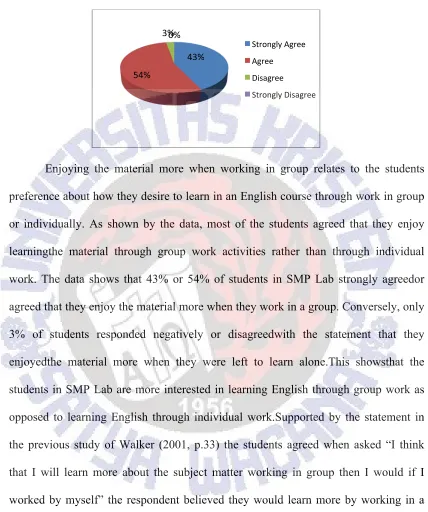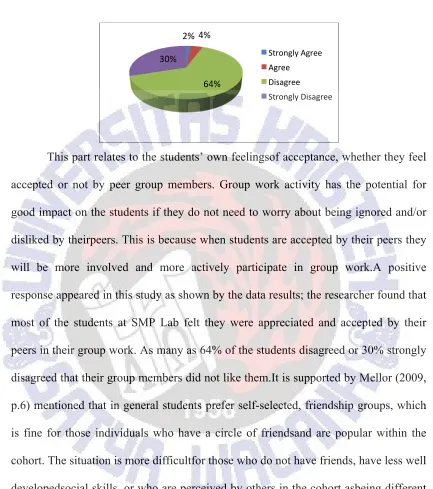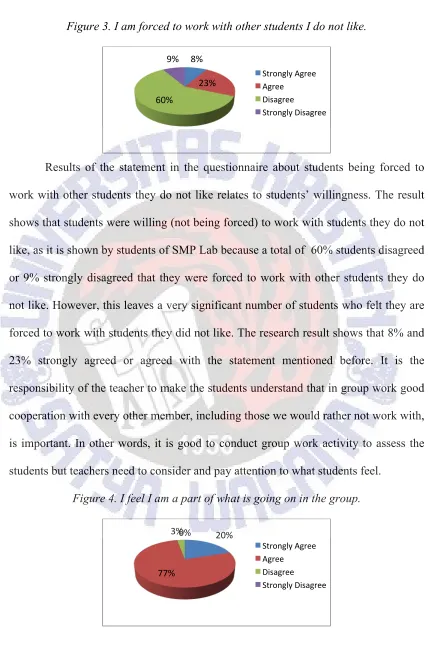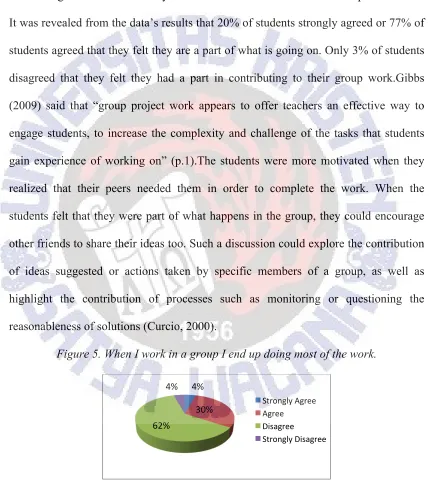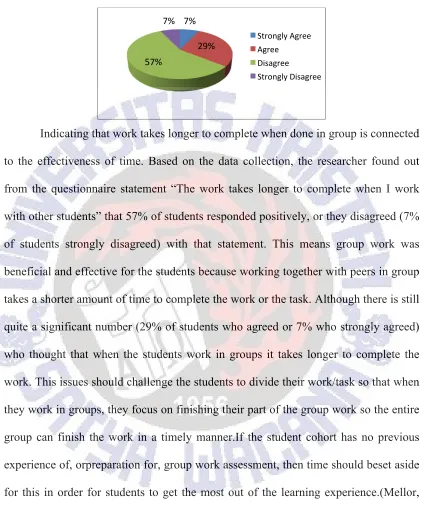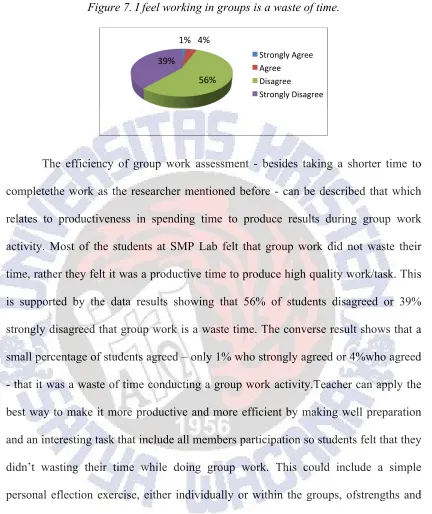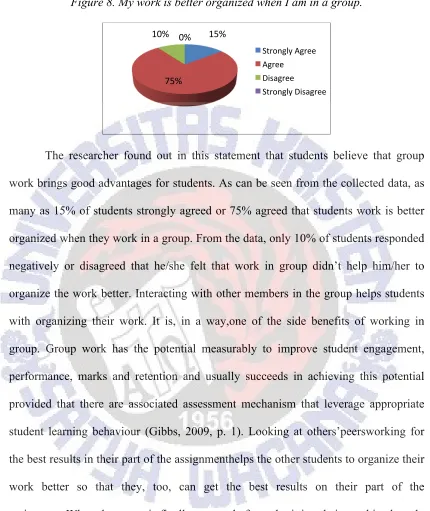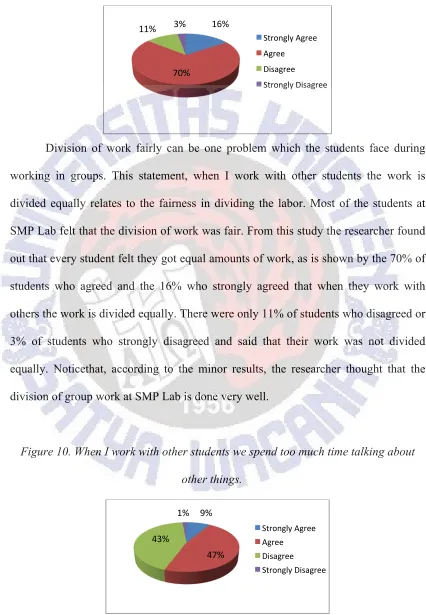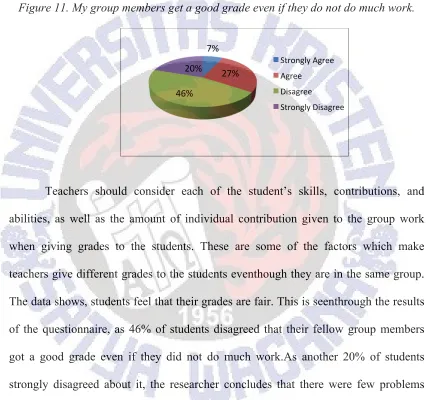E. FINDING AND DISCUSSSION
This section discusses the research findings trying to answer the research
question about the perception of junior high students toward group work assessment,
especially in an English course. The answer is presented below in three themes based
on the fourteen questions of the questionnaire, shown by the amount of questions
answered by the students from the total of 70 questionnaires, with the description
opinion being Strongly Agree (SA), Agree (A), Disagree (D), or Strongly Disagree
(SD) in percentage.
The first theme is aimed at identifying the students’ affection for participating
group work activity in English class. This part discusses about students’ motivation
and students’ point of view during group work activity in English class. The second
theme aims to identfiying the efficiency or the effectiveness of participating in group
work assessment in class. Finally, the third theme is aimed at gaining information
about students feeling toward fairness and unfairness of grades as a result of the group
work assessment.
E.1. Students’ affect in participating Group Work Assessment
Students’ motivation is a crucial part in participating in a group work.
Motivation relates to students’s affection, which refers to what the students feel and
think emotionally during the learning prossess in group work assessment. What are
the powerful reasons that push them or motivate them to get involved in group work
activity? Some factors that describe their motivation relate to the materials discussed,
Figure 1. I enjoy the material more when I work with other students.
Enjoying the material more when working in group relates to the students
preference about how they desire to learn in an English course through work in group
or individually. As shown by the data, most of the students agreed that they enjoy
learningthe material through group work activities rather than through individual
work. The data shows that 43% or 54% of students in SMP Lab strongly agreedor
agreed that they enjoy the material more when they work in a group. Conversely, only
3% of students responded negatively or disagreedwith the statement that they
enjoyedthe material more when they were left to learn alone.This showsthat the
students in SMP Lab are more interested in learning English through group work as
opposed to learning English through individual work.Supported by the statement in
the previous study of Walker (2001, p.33) the students agreed when asked “I think
that I will learn more about the subject matter working in group then I would if I
worked by myself” the respondent believed they would learn more by working in a
group rather than working alone.
43%
54% 3% 0%
Figure 2. My group members do not like me.
This part relates to the students’ own feelingsof acceptance, whether they feel
accepted or not by peer group members. Group work activity has the potential for
good impact on the students if they do not need to worry about being ignored and/or
disliked by theirpeers. This is because when students are accepted by their peers they
will be more involved and more actively participate in group work.A positive
response appeared in this study as shown by the data results; the researcher found that
most of the students at SMP Lab felt they were appreciated and accepted by their
peers in their group work. As many as 64% of the students disagreed or 30% strongly
disagreed that their group members did not like them.It is supported by Mellor (2009,
p.6) mentioned that in general students prefer self-selected, friendship groups, which
is fine for those individuals who have a circle of friendsand are popular within the
cohort. The situation is more difficultfor those who do not have friends, have less well
developedsocial skills, or who are perceived by others in the cohort asbeing different
or odd.The researcher found out that most of the students at SMP Lab have well
developed social skills in the context of human interaction so that everyone perceived
each others’ needs and felt they were liked by peers.
2% 4%
64%
30% Strongly Agree
Figure 3. I am forced to work with other students I do not like.
Results of the statement in the questionnaire about students being forced to
work with other students they do not like relates to students’ willingness. The result
shows that students were willing (not being forced) to work with students they do not
like, as it is shown by students of SMP Lab because a total of 60% students disagreed
or 9% strongly disagreed that they were forced to work with other students they do
not like. However, this leaves a very significant number of students who felt they are
forced to work with students they did not like. The research result shows that 8% and
23% strongly agreed or agreed with the statement mentioned before. It is the
responsibility of the teacher to make the students understand that in group work good
cooperation with every other member, including those we would rather not work with,
is important. In other words, it is good to conduct group work activity to assess the
students but teachers need to consider and pay attention to what students feel.
Figure 4. I feel I am a part of what is going on in the group. 8%
23%
60% 9%
Strongly Agree Agree Disagree Strongly Disagree
20%
77% 3% 0%
Becoming a part of what is going on in the group is relatedtostudents’role in
participating in group workand relates to how much they perceive that they contribute
to completing the task.The result of the study refers to the fact that every student at
SMP Lab got involved and everyone made contributions in order to complete the task.
It was revealed from the data’s results that 20% of students strongly agreed or 77% of
students agreed that they felt they are a part of what is going on. Only 3% of students
disagreed that they felt they had a part in contributing to their group work.Gibbs
(2009) said that “group project work appears to offer teachers an effective way to
engage students, to increase the complexity and challenge of the tasks that students
gain experience of working on” (p.1).The students were more motivated when they
realized that their peers needed them in order to complete the work. When the
students felt that they were part of what happens in the group, they could encourage
other friends to share their ideas too. Such a discussion could explore the contribution
of ideas suggested or actions taken by specific members of a group, as well as
highlight the contribution of processes such as monitoring or questioning the
reasonableness of solutions (Curcio, 2000).
Figure 5. When I work in a group I end up doing most of the work.
In this statement that one of students might end up doing most of the work the
questionnaire is revealing the students’ feelingstowarddivision of the task while
working in group. Students at SMP Lab felt that while they are working with a group
4%
30%
62% 4%
they have effective cooperation. This means that students felt that the division of work
was relatively balanced, although it does not mean that everyone was satisfied with
the amount of work he/she received. It is also proven by the data shown that most of
the students are working together and consider themselves a group. Every student
received an equal job and they were all making equal contributions in finishing their
assignment. The results show that 62% of students disagreed and 4% strongly
disagreed that they end up doing most of the work in group. It means these students
are considering their own responsibilities in finishing their part of the work. In spite
of this, a significant number of the students (30% and 4%) responded
negatively.Considering it is not a small percentage, the teachers should pay attention
and find out better waysto ensure that each student contributes fairly so there will be
less students who feel that group work creates a disadvantage for him/her. For
instance teacher could do peer evaluation in group work,“I support peer evaluation
because I, as a leader, am unable to push members to do work at the end, I do most of
the work. I believe that with peer evaluation, all group members will cooperate and
work harder the project work will be of higher quality “(Poon, 2011, p.4)
E.2. The efficiency of the group work Assessment
This section discusses the efficiency of the group work assessment.
Identification of efficiency mostly relates to the effectiveness of the group work. Most
Figure 6.The work takes longer to complete when I work with other students.
Indicating that work takes longer to complete when done in group is connected
to the effectiveness of time. Based on the data collection, the researcher found out
from the questionnaire statement “The work takes longer to complete when I work
with other students” that 57% of students responded positively, or they disagreed (7%
of students strongly disagreed) with that statement. This means group work was
beneficial and effective for the students because working together with peers in group
takes a shorter amount of time to complete the work or the task. Although there is still
quite a significant number (29% of students who agreed or 7% who strongly agreed)
who thought that when the students work in groups it takes longer to complete the
work. This issues should challenge the students to divide their work/task so that when
they work in groups, they focus on finishing their part of the group work so the entire
group can finish the work in a timely manner.If the student cohort has no previous
experience of, orpreparation for, group work assessment, then time should beset aside
for this in order for students to get the most out of the learning experience.(Mellor,
2009, p. 7) In this case the teacher can help studentsset aside time to divide the work
so students can finish the task quickly and the time is used effectively.
7%
29%
57% 7%
Figure 7. I feel working in groups is a waste of time.
The efficiency of group work assessment - besides taking a shorter time to
completethe work as the researcher mentioned before - can be described that which
relates to productiveness in spending time to produce results during group work
activity. Most of the students at SMP Lab felt that group work did not waste their
time, rather they felt it was a productive time to produce high quality work/task. This
is supported by the data results showing that 56% of students disagreed or 39%
strongly disagreed that group work is a waste time. The converse result shows that a
small percentage of students agreed – only 1% who strongly agreed or 4%who agreed
- that it was a waste of time conducting a group work activity.Teacher can apply the
best way to make it more productive and more efficient by making well preparation
and an interesting task that include all members participation so students felt that they
didn’t wasting their time while doing group work. This could include a simple
personal eflection exercise, either individually or within the groups, ofstrengths and
weaknesses, perhaps as part of an icebreakersession (Mellor, 2009, p.7).
1% 4%
56%
39% Strongly Agree
Figure 8. My work is better organized when I am in a group.
The researcher found out in this statement that students believe that group
work brings good advantages for students. As can be seen from the collected data, as
many as 15% of students strongly agreed or 75% agreed that students work is better
organized when they work in a group. From the data, only 10% of students responded
negatively or disagreed that he/she felt that work in group didn’t help him/her to
organize the work better. Interacting with other members in the group helps students
with organizing their work. It is, in a way,one of the side benefits of working in
group. Group work has the potential measurably to improve student engagement,
performance, marks and retention and usually succeeds in achieving this potential
provided that there are associated assessment mechanism that leverage appropriate
student learning behaviour (Gibbs, 2009, p. 1). Looking at others’peersworking for
the best results in their part of the assignmenthelps the other students to organize their
work better so that they, too, can get the best results on their part of the
assignment.When the group is finally assessed after submitting their combined work,
they can achieve their best effort to get the best possible grade.
15%
75% 10% 0%
Figure 9. When I work with other students the work is divided equally.
Division of work fairly can be one problem which the students face during
working in groups. This statement, when I work with other students the work is
divided equally relates to the fairness in dividing the labor. Most of the students at
SMP Lab felt that the division of work was fair. From this study the researcher found
out that every student felt they got equal amounts of work, as is shown by the 70% of
students who agreed and the 16% who strongly agreed that when they work with
others the work is divided equally. There were only 11% of students who disagreed or
3% of students who strongly disagreed and said that their work was not divided
equally. Noticethat, according to the minor results, the researcher thought that the
division of group work at SMP Lab is done very well.
Figure 10. When I work with other students we spend too much time talking about
other things.
16%
70% 11% 3%
Strongly Agree Agree Disagree Strongly Disagree
9%
47% 43%
1%
Although there are many advantages and benefits to group work discussed,
there also appeared a negative side of the group work assessments for students. From
the research data collected, the results revealed a serious problem because over half of
the students agreed (47% agreed or 9% strongly agreed) that students were talking
about other things during group work activities in class rather than focusing on the
group work at hand. It is also considered that students wasted their time talking about
other things instead of focusing on completing their work. Furthermore, this lack of
focus can be related to students wasting their time instead of producing results. In the
same line with Davies (2009) agreed that some group members may be reluctant
participants in assessment tasks and be uncommited to the aims of the group (p. 566).
Comparing the smaller numbers with the percentage before, the result shows that 43%
of students disagreed or 1% strongly disagreed with the statement creates a challenge
for the teachers as teachers musthelp students focus only on what they should in order
to finish their group work activities and assignment. Teachers can create more
interesting ways to help the students stay focused and become interested in what they
are doing, helping students to avoid talking about other things.
E.3. The fairness and unfairness of group work assessments’ grades
Grades are the reward for the final results when measuring what students have
accomplished. The students will see how deserving their achievement is, how much
they have acomplished, and what they have done during the learning process as this
will be reflectedin their grades. Grades could be the main problem in discussing group
work assessment. Dissatisfaction with assessment processes and with marks awarded
Based on what the researcher has experienced duringthe teaching practicum, giving
grades in groups is not as simple as giving individual grades because more than one
person needs to be assessed for the same work and in the same group with the
different abilities, different characters, different motivation, etc.
Figure 11. My group members get a good grade even if they do not do much work.
Teachers should consider each of the student’s skills, contributions, and
abilities, as well as the amount of individual contribution given to the group work
when giving grades to the students. These are some of the factors which make
teachers give different grades to the students eventhough they are in the same group.
The data shows, students feel that their grades are fair. This is seenthrough the results
of the questionnaire, as 46% of students disagreed that their fellow group members
got a good grade even if they did not do much work.As another 20% of students
strongly disagreed about it, the researcher concludes that there were few problems
with assessing students at SMP Lab through group work assessment. It is shown by
the 27% of the students who agree and the 7% of students who strongly agreed that
there were group members who get the same grades even if they do not do much
work. Notice that there are some problems might appear in assessing students teacher
could have a rubric assessement which have components that need to be assessed so it
7%
27%
46%
20% Strongly Agree
would help the teacher in giving grade for each component such as how much
students’ contribution as Gibbs (2009) said:
insome circumstances, such as during supervised fieldwork or laboratory work, it will be possible for the teacher to gain an adequate impression of the relative contribution of individuals to the group work simply by informal observation. Such observation can be formalized through rating individuals on a common set of scales concerning contribution to different components of the work (such as collecting data or writing up), or different process variables (such as ‘effort’ or ‘ideas’). In most circumstances, however, such observation would provide an incomplete basis for judging at least some individual members of most groups. An alternative approach that is fairer to students would be to collect additional evidence about each individual (p. 6).
Figure 12. I do not think a group grade is fair.
Still in discussion about fairness and unfairness of group work grades, the
research data collected shows that students feel that the grades were fair for them.
Students’ answer based on the data suggested that the teachers were treating the
students fairly. Almost ¾ of the students at SMP Lab disagreed (67%) or strongly
disagreed (3%) with the statement that they did not think a group grade was fair,
which meant that group work grades seemed fair to the majority of students assessed
through group work.However, the data also showed that 24% of students agreed and
6% strongly agreed that a group grade was not fair. In this case, if the students have a
complaint, the teacher can explain and show the transparancy of the grading factors
6%
24%
67% 3%
that are included in the process of grading by using the rubric assessement that the
researcher mentioned in the previous figure.
Figure 13. When I work in a group I get the grade I deserve.
Besides comparing to other peers’ grades, the students should reflect on their
own ability individually. Each student should reflect on what their group members
havedone and what each of the other students has accomplished. Each student should
acknowledge their own abilities and their own skills before they decide that the grade
is fair or unfair for them. This research study shows the good response of the students
toward the grades they deserve. As many as 70% of students agree and 20% strongly
agree that they get the grades they deserve. Most of the students felt that the grade
they got was what they deserved for their achievements. Only 10% of students felt
that they did not get the grade that they deserved. Based on this comparison,only a
small amount of the students were dissatisfied with their grades from group
assessments, so it should not be a problem for the teacher to assess the students using
group work, provided teachers assess each student individually based upon each
student’s contribution towards the group effort. So it was expected that satisfaction
with marks would be positively associated with overall satisfactionwith group work.
(Burdett, 2009, p. 63)
20%
70% 10% 0%
Figure 14. My marks improve when I work with other students.
Fairness and unfairness usually relate more to students’ feelings of satisfaction
or disatisfaction with how they have been assessed. The research data from this study
at SMP Lab shows that 50% of students agreed and 21% of students strongly agreed
that their grades improvedwhen they work in groups. They were satisfied about the
way teachers chose group work assessments in order to measure their abilities. It was
a good result that this study identifiedthe reality that group work assessment helps
students improve their grades. This showed that students prefer to be assessed through
group work rather than individually.Students believed that byworking in group,
members would help each other within the group. They will learn during the working
process to give their best effort because every student always wants to get high
grades“we students arerealistic and will focus on doing things that can get higher
marks…” (Poon, 2011, p. 4)
CONCLUSION
This study was conducted to gain information about junior high students’
perception toward group work assessments. It was revealed that students are highly
motivated and more interested to learn English materials through the group work
21%
50% 26%
3%
assessments. There are some factors that support students having high motivation
working in group. The first factoris external, connected to howshe/he
perceivedacceptance by peers. The researcher found out that peers can greatly
contribute to the students’ desire to partipate in group work activities (and vice versa).
The studentswho are appreciated and well-liked by their friends enjoyed doing group
work. Along with the factor of the impact of peers,another factor– and intrinsic factor
- relates to the students’ feelings. Students who feel that they have experienced good
cooperation and interaction with peers also feel that they are a part of what was
happening during the group activities.
From the results of study the researcher also identified that group work
assessment can be one of the better techniques to assess the students’ abilities. It is
shown by the results of this study that most students believe that group work
assessment is helpful and has many benefits for the students. Most of the students
agreed that through group work assessment they can improve their grades;
furthermore, their work is also better organized when they work in groups as
compared to when they work individually. Not only are the students’ grades
increasedby working in groups, but alsotheir work is done more quickly and more
effectively since they completing the workwith others. All of the resultsshow that the
students responded positively about their perception toward group work assessments
in class. Of coursesome of the students observed that the group work required the
students to talk with others, thereforeit may be a risk to talk about other things while
discussing the work assignment.
Finally, the fairness and unfairness of grades as final results in reflecting
discussed.This study reveals that students prefer group work in assessing their
abilities and their work. The students are satisfied with the methods teachers use when
giving their grades. The students felt that they received the grades they deserved in
correlation with the quality of work which they had done. The students also felt that
the grading systemsemployed by the teachers was fair and even felt that their grades
improved when they worked in groups rather than working individually.
However, the researcher noticed that there are some limitations and
weaknesses in this study. First, this study was designedin relatively small sampling,
limited to eight grade students so the findings presented may not be applicable for use
at all levels of junior high school. Second, this study was conducted during group
work activity so there are some factors that will make different results. For example if
this study was conducted in a class where there was no group assignment, students
would not face obstacles during group work, students have no responsibility toward a
group assignment and would not experiencerespectively relying on other group
members.Furthermore, this study also may not be approriate for teachers of different
subjects because not all of the subjects of study could be assessed by using group
work activities. This method might be accepted by various teachers differently; for
instance, other teachers may have different ways or systems of giving students’ grades
through group work assessments.Therefore the researcher hopes that this study can be
used as a reference to develop, aid, and encourage English teachers in assessing
students when the teachers face a challenge related to group work assessments.Future
research could be done to give even greater insight about group work assessment, thus
strengthening teachers’ ability to assess students more accurately and effectively
